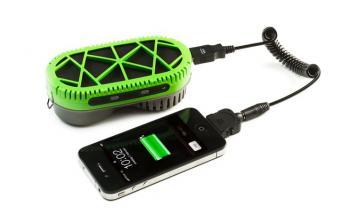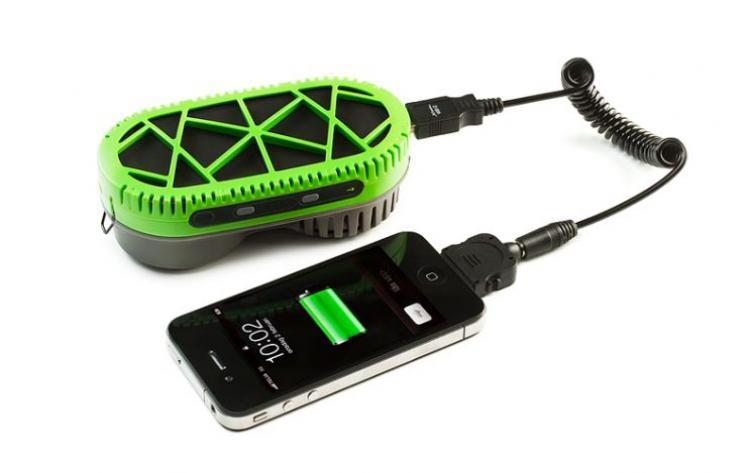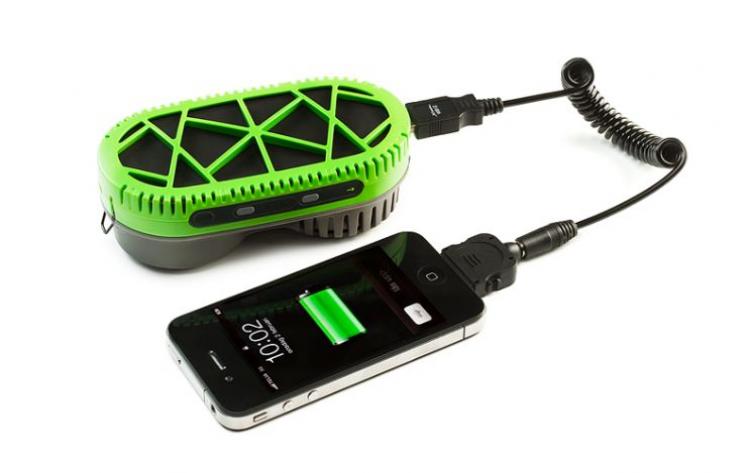The work of a “retired” chemistry professor has led to the discovery of a new, clean, green instant energy source that can power a portable electronics charger.
Aimed at the outdoor enthusiast, the charger could also prove valuable to residents of Third World countries where electricity is not always readily available, said the developers.
James Dye joined Michigan State University (MSU) in 1953. He officially retired nearly 17 years ago, but continues to frequent the lab in the chemistry department’s basement, inspiring undergraduate students with his love of chemistry.
For 50 years Dye has worked with alkali metals—a group of highly reactive elements including sodium and lithium that are known for being dangerous to store and work with. Dye found a way to stabilize alkali metals with silicon, turning them into a safe powder.
“In our lab, we were able to produce alkali metal silicides, which basically are made from sodium and silicon, which, in turn, are produced from salt and sand,” Dye said in an MSU press release.
“By adding water to sodium silicide, we’re able to produce hydrogen, which creates energy for fuel cells. The byproduct, sodium silicate, is also green. It’s the same stuff found in toothpaste.”
Last month, the company Dye co-founded, SiGNa Chemistry Inc., unveiled its new Mobile-H2 hydrogen cartridges, which are the energy source for the pocket-sized PowerTrekk, a wireless portable electronics charger developed by Swedish fuel cell technology company myFC.
The cartridges are filled with sodium silicide, which produces low-pressure hydrogen gas when water—about a tablespoon—is added. A fuel cell converts the hydrogen to electricity. A Li-ion battery pack in the PowerTrekk charger acts as a buffer and a secondary power source.
Users can power or charge up devices such as mobile phones, cameras, GPS devices, and mp3 players by connecting them to the PowerTrekk via a USB port.
The only byproduct is water vapor and any water source can be used, including dirty and salt water, said the developers.
“SiGNa has created an inherently safe solution to produce electric power, resulting in an eco-friendly and cost-effective portable solution,” said Michael Lefenfeld, SiGNa’s CEO, in a press release.
“PowerTrekk has a competitive edge over traditional portable chargers. Fuel cell power is generated immediately and charging is not impacted by weather or the position of the sun, as for solar panels. Compared to battery powered travel chargers, PowerTrekk offers reliable charging as the fuel packs do not deplete as batteries do,” said Björn Westerholm, CEO of myFC, in a press release.
PowerTrekk was exhibited at the Mobile World Congress in Barcelona, Spain, in February. myFC plan to launch the product commercially later this year.
For more information on the PowerTrekk visit www.powertrekk.com
Aimed at the outdoor enthusiast, the charger could also prove valuable to residents of Third World countries where electricity is not always readily available, said the developers.
James Dye joined Michigan State University (MSU) in 1953. He officially retired nearly 17 years ago, but continues to frequent the lab in the chemistry department’s basement, inspiring undergraduate students with his love of chemistry.
For 50 years Dye has worked with alkali metals—a group of highly reactive elements including sodium and lithium that are known for being dangerous to store and work with. Dye found a way to stabilize alkali metals with silicon, turning them into a safe powder.
“In our lab, we were able to produce alkali metal silicides, which basically are made from sodium and silicon, which, in turn, are produced from salt and sand,” Dye said in an MSU press release.
“By adding water to sodium silicide, we’re able to produce hydrogen, which creates energy for fuel cells. The byproduct, sodium silicate, is also green. It’s the same stuff found in toothpaste.”
Last month, the company Dye co-founded, SiGNa Chemistry Inc., unveiled its new Mobile-H2 hydrogen cartridges, which are the energy source for the pocket-sized PowerTrekk, a wireless portable electronics charger developed by Swedish fuel cell technology company myFC.
The cartridges are filled with sodium silicide, which produces low-pressure hydrogen gas when water—about a tablespoon—is added. A fuel cell converts the hydrogen to electricity. A Li-ion battery pack in the PowerTrekk charger acts as a buffer and a secondary power source.
Users can power or charge up devices such as mobile phones, cameras, GPS devices, and mp3 players by connecting them to the PowerTrekk via a USB port.
The only byproduct is water vapor and any water source can be used, including dirty and salt water, said the developers.
“SiGNa has created an inherently safe solution to produce electric power, resulting in an eco-friendly and cost-effective portable solution,” said Michael Lefenfeld, SiGNa’s CEO, in a press release.
“PowerTrekk has a competitive edge over traditional portable chargers. Fuel cell power is generated immediately and charging is not impacted by weather or the position of the sun, as for solar panels. Compared to battery powered travel chargers, PowerTrekk offers reliable charging as the fuel packs do not deplete as batteries do,” said Björn Westerholm, CEO of myFC, in a press release.
PowerTrekk was exhibited at the Mobile World Congress in Barcelona, Spain, in February. myFC plan to launch the product commercially later this year.
For more information on the PowerTrekk visit www.powertrekk.com





